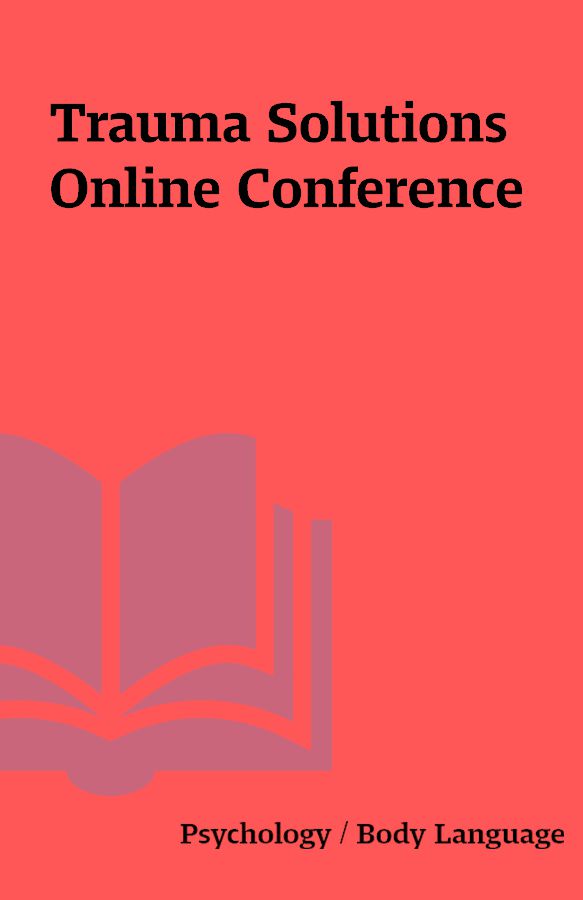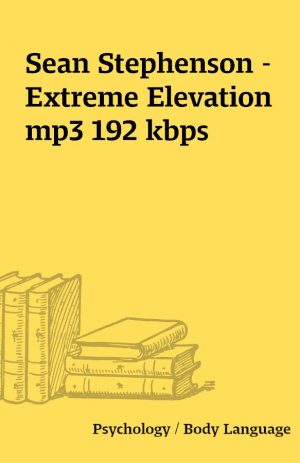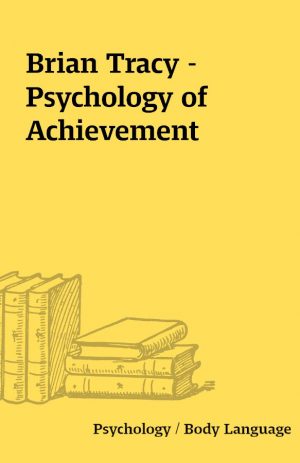Trauma Solutions Online Conference
Trauma Solutions Online Conference
[WEBRIP=3 MP4-17 PDF-11 MP3]
Description
***************************************************************This is the result of a GB. Sharing outside is forbidden***************************************************************Trauma Solutions Online Conference GBhttp://solutionsfortrauma.com/Achieve a higher success rate and create powerful and respectful solutions for even your most traumatized clients.We have gathered together experts in experiential methods of trauma treatment and asked them to give you their best strategies for treating trauma using mindfulness approaches, Ericksonian approaches, somatic psychotherapy and brief therapy . They will share with you their tips and strategies and show you how to dramatically improve your performance when working with your clients who have been traumatized.Attend online at anytime (no fixed dates) and from anywhere…without spending 1000’s of dollars on conference fees, airfares and hotels.Your Presenters Dr. Michael Yapko – Setting The Stage: “Mindfulness and Hypnosis: The Power of Suggestion to Transform Experience”The full presentation will help you get the most from this conference on treating trauma. It is recommended that you listen to it first, before moving onto the presentations on trauma treatment by Ronald Siegel, Dan Short, Maggie Phillips, Bill O’Hanlon and the others. It based on Michael’s book of the same name and is a breathtaking overview of the similarities and differences between mindfulness and hypnosis and how you can (if you chose) use one to amplify these other. Just a sample of what Michael covers in his presentation1) How mindfulness and hypnosis are related in both form and function2) The basis of experiential learning that applies to both mindfulness and hypnotic interventions.3) Some critical considerations of employing guided mindfulness meditations in treatment.4) The language of mindfulness and hypnosis and how to use that language for maximum impact with your clients and patients.Michael Yapko is both a visionary and pioneer in the teaching of hypnosis and of its use in many areas. Michael is not only a clinician with over 30 years practice but also an author who has written over a dozen highly-acclaimed books, including his latest, Mindfulness and Hypnosis: The Power of Suggestion to Transform Experience.Dr. Yapko is a member of the American Psychological Association, a clinical member of the American Association for Marriage and Family Therapy and has written and edited thirteen books, including Breaking the Patterns of Depression, Treating Depression with Hypnosis, and Hand-Me-Down Blues: How to Stop Depression from Spreading in Families. His newest book, Depression is Contagious, was just released in September (2009) from The Free Press, a division of Simon and Schuster. His works have been published in nine languages.Dr. Ronald D. Siegel”Mindfulness and Trauma Treatment: Tailoring the Practice to the Person”Mindfulness-based psychotherapy is the most popular new treatment approach in the last decade—and for good reason. Mindfulness practices hold great promise not only for our own personal development, but also as remarkably powerful tools to augment virtually every form of psychotherapy.Mindfulness is not, however, a one-size-fits-all remedy. Practices need to be tailored to fit the needs of particular individuals—and this is particularly important when our client or patient has a trauma history. This presentation will explore seven important decisions clinicians should consider when introducing mindfulness practices into the treatment of traumatized individuals, presenting practical guidelines about how to tailor practices to your clients’ or patient’s particular circumstances.A small part of what you will learn with Dr. Siegel:Learn seven important decisions you should consider when introducing mindfulness practices, including which mindfulness skills to emphasize and in what form.Understand how mindfulness practices can and should be tailored to the needs of particular types of clients.Understand potentially adverse effects of meditation (such as de-repression).Practical guidelines about how to specifically tailor practices to your client particular life circumstances and needsThe importance of choosing an object of focus that fits for the particular needs of each client (and how to adjust that object as the client progresses.Find out why some very popular and common meditations are NOT recommended for traumatized clients (and what to use instead).Learn how to choose the right meditation at the right time so that you can be maximally effectives as a therapist.Common myths and misconceptions about mindfulness that your clients may have and how to deal withDr. Ronald D. Siegel is an Assistant Clinical Professor of Psychology at Harvard Medical School, where he has taught for over 30 years. He is a long time student of mindfulness meditation and serves on the Board of Directors and faculty of the Institute for Meditation and Psychotherapy.He teaches internationally about the application of mindfulness practice in psychotherapy and other fields, and maintains a private clinical practice in Lincoln, Massachusetts. Dr. Siegel is coauthor of the self-treatment guide Back Sense: A Revolutionary Approach to Halting the Cycle of Chronic Back Pain, which integrates Western and Eastern approaches for treating chronic back pain; coeditor of the critically acclaimed text, Mindfulness and Psychotherapy, author of a book for general audiences, The Mindfulness Solution: Everyday Practices for Everyday Problems, and coeditor of the recently released Wisdom and Compassion in Psychotherapy: Deepening Mindfulness in Clinical Practice, with a foreword by His Holiness the Dalai Lama. He is also a regular contributor to other professional publications, and is co-director of the annual Harvard Medical School Conference on Meditation and Psychotherapy.Dr. Dan Short”Using Ericksonian Hypnosis for Trauma Work and Memory Reconsolidation”In this presentation, Dan will demonstrate how Ericksonian trauma work is primarily a process of gradually reorienting the client to the goodness of the body, the mind, and all that has been experienced during a lifetime of learning. Memory reconsolidation occurs as memories are physically altered and re-encoded with new emotional elements. During this creative process, a new sense of self is forged within your clients as he or she grows more confident and more emotionally prepared to deal with future challenges.A small part of what you will learn:The mechanisms by which memory reconsolidation occurs (and how to begin working with it.The crucial differences between productive recall work and destructive recall work.Understand and utilize the various situational factors necessary for creating a safe therapeutic environmentThe utility of hypnosis in trauma treatment and how to use it to be a better therapist.Dr. Dan Short is internationally recognized for his work in brief therapy, which began with a specialization in domestic violence. As a counselor in a domestic violence intervention program, Dan established new innovative methods of treatment and was recognized early work in trauma treatment for perpetrators of violence. Later, Dan worked with students at the University of Massachusetts with substance abuse issues. Dan has worked in the public schools as a school psychologist for students with behavioral and emotional problems. He now teaches at institutes around the world and maintains a private practice, in Scottsdale, Arizona. Dan is the lead author of Hope and Resiliency, and sole author of Transformational Relationships, books for professional care providers, which have received world-wide attention.Dr. John LentzHealing Trauma Indirectly and With SubtletyIn this presentation you will learn very subtle ways of using sophisticated tools and approaches to deal with trauma. These approaches were developed over decades of working in a prison by the author, and owe much to the work of Milton Erickson and his students.Hypnosis was simply not something that could be openly used in treating inmates in the 80’s and so the author developed methods that work using the knowledge of hypnosis without using it. The result is subtlety. Today these approaches are backed up by neuroscience as well as clinical experience. Participants will learn short, subtle ways of dealing with trauma that work and have worked on folks with such massive traumatized backgrounds that they ended up in prison.John will teach you many different strategies for treating trauma including:A deeper understanding of the pathways through which trauma can be healed (and how to utilize them).Learn the essence of how trauma is developed so that you work with it more effectively.Why and How “Trances” can be utilized to move into healthy engagement.Build on your own strengths and processes by discovering how you already know and utilize effective strategies for trauma treatment.John Lentz. After teaching for over 18 years the Clinical aspects of Psychotherapy at the Louisville Presbyterian Seminary and providing therapy as the Chief Chaplain at the women’s prison in Kentucky, Dr. Lentz now teaches nationally and internationally. His work reflects a unique combination of practical work with incarcerated individuals and the rigors of an academic approach. His books and presentations tend to reflect his work at the prison in ways that make the points memorable and are a way of his respecting the women he learned from. Currently he is the Director of the Ericksonian Institute of Jeffersonville, Indiana where he teaches and practices hypnosis and marriage and family therapy. He is also the part time minister at Radcliff Presbyterian Church where his sermons are as hypnotically helpful as he can make them.Drs. Carol Kershaw and Bill WadeFrom Trauma to Thriving: Neuroscience and Hypnosis for Successful LivingBy using hypnosis based in neuroscience research, the continuum of trauma can be resolved through Hypnotic Bilateral Stimulation™ and Deep State hypnosis. The presenters offer strategies for amygdala calming and a 4 stage Realignment Process to reset the brain/mind/body and move into thriving. You can begin using nearly all of these interventions in your practice quickly and easily.Learn to resolve trauma through “Deep State Hypnosis” and hypnotic bilateral stimulation.Learn the implications of the latest neuroscience discoveries in treating trauma.Discover how to provide an often forgotten crucial step in recovery: training in resilience.Learn specific integration techniques and strategies that are easy to learn and simple to put into practice with nearly any client.Dr. Enayatollah ShahidiHypnotherapy of the Traumatized PatientIn this presentation Dr. Shahidi clarifies the relationship between trauma, dissociation and the dissociative symptoms and demonstrates how hypnotherapeutic techniques such as Imaginary Protective Gear, Inner Safe Place, Containment of Traumatic Memories, Hypno-projection, Dissociation Round-table, Ego Strengthening, Affect Bridge, Inner Child Journey, Reparenting, and The Holy Figuren can be used to heal trauma.Dissociation is the key concept to understanding traumatization. Dissociation is an effective and adaptive defense against trauma as it is occurring, but can become a vehicle for the development of trauma-related Dissociative Disorders (DD’s).Following exposure to traumatizing event(s), some individuals fail to integrate the experience in their personality. They may have limited awareness of their traumatization, e.g. low level or retracted field of consciousness, partial to complete dissociative amnesia, bodily anesthesia, and emotional numbness. The survivors may also have flashbacks or dreams of the traumatizing events or re-experience these events as if they are taking place right here and now. As a matter of fact they live in “Trauma Time”.They traumatized individual may lack adequate integrative capacity and mental skills required to fully defuse and integrate their experiences. As a matter of fact patients suffering from truama and post-traumatic dissociative disorders are usually in trance state. The Patients behave exactly like hypnotized subjects and their involuntary reactions are in complete accordance with the disturbing imaginations. Hence, hypnotherapeutic strategies can play an important role in the treatment of traumatized patients.Learn to utilize 10 potent and efficient hypnotherapeutic techniques and how to apply them in the treatment of traumatized patients.Show you how to break the patterns of trauma down in to largely predictable components (making trauma MUCH easier to treat.)Teach your clients how to use hypnotherapeutic techniques via self-hypnosis to enhance the therapeutic effect.Learn how hypnotizability is considered as a double-edged sword and why patients suffering from trauma-related Dissociative Disorders are likely to be highly hypnotizable.Enayatollah Shahidi, MD, PhD, is a licensed Medical Doctor and a Cognitive-Behavioral Psychotherapist residing in Tehran, Iran. He is a well-recognized author, translator, lecturer, and therapist in the fields of CBT, EMDR, and medical and psychological hypnosis. He has been a BOD member and Treasurer of Iranian Scientific Society of Clinical Hypnosis (ISSCH) and has recently been elected as the Vice-president, Treasurer, and Chairman of the International Affairs Committee. He is the author of four Persian books and has translated 9 books into Persian language, four of which from Italian and the other five books from English.Gordon YoungBreaking the Patterns of Trauma: Creating Effective Treatments for TraumaTrauma, like any issue is treated according to how you define it. Many trauma treatments make a clear connection between external events and trauma, as if certain events will almost automatically create trauma. This implies that certain events are intrinsically damaging. Whilst I don’t disagree with this totally, it begs the question why some people can be traumatised by an event, whilst others move on quickly. It also doesn’t really explain vicarious trauma.This presentation explores why people differ in their responses claiming that certain people are more prone to trauma because of their cognitive style, and claims that trauma and PTSD are processes- that is to say, there are a series of steps required…a “how to” if you will. It shows you briefly how to break down trauma into its component parts and heal it.The process is a type of guided visualization that is designed to “run interference” on the client’s visual recall of the event thereby creating a level of dissociation from it. Gordon also discusses some of the key aspects of memories and how you can help your client work with them, including:Learn to conceptualize trauma and PTSD as a process or pattern rather than a “condition.”Show you how to break the patterns of trauma down in to largely predictable components (making it MUCH easier to treat.Trauma healing as a process, not an eventExplore a theoretical perspective that explains the range of responses we see to crisis, and that can assist in helping those likely to have trauma.Gordon Young runs the highly regarded Mondo Clinic (named after his late father) in Sydney, Australia. And spreads his time between training therapists and coaches, and working with corporations to highlight the benefits of supporting the “human professional” in the workplace. Gordon was the President of the Australian Society of Clinical Hypnotherapists, Chair of the Australian Board of Neuro Linguistic Programming, Editor of the Australian Journal of Clinical Hypnotherapy and Hypnosis, an appointed supervisor for the ACA, ASCH, AHA, Member of the International Coaching Federation (ICF), Member of the British Institute of Hypnotherapy (BIH), Founder of Intra-Personal Relationship Therapy, and a published author in the field.Rob McNeilly, MD (MBBS)”Trauma to Healing: From a Bad Trance, Dance to Enhance” Whenever someone experiences trauma, there is a natural experience of focused, absorbed attention. After the trauma is over, memories of that trauma, which can be images, body sensations or emotions can continue to haunt some people. Much of the post traumatic problem shares similarities with a hypnotic trance – the dissociation from present time, a regression to the time of the trauma, alterations of experience [sensations, memories, expectancy] – so hypnosis offers a fitting opportunity to transform the problematic experience of the past trauma into a preferred present experience and a future anticipation.In this presentation we will explore these similarities between hypnotic states and trauma and offer approaches that that will help you use hypnosis to heal trauma, including:Learning the connection between trauma and hypnosis.Utilizing your client’s ability to keep the trauma active through focus and absorption as a means of healing the trauma.Explore ways of utilizing focus and absorption to create a solution unique to each individual person.Help your clients reconnect with their resources.Anecdotes and stories that will help you to integrate trauma techniques into your practice and life.Rob McNeilly is widely known throughout Australia, New Zealand and Southeast Asia and Scandinavia. He is a regular invited presenter to the Milton H Erickson Foundation’s International Conferences. He is the author and co-author of several books and DVD’s series on empirically based methods for learning effectiveness in therapy. A former medical doctor, Rob McNeilly retired from medical practice nearly 30 years ago after meeting and working with Milton Erickson. He did so to focus exclusively on engaging in brief therapy and hypnosis. Rob is known for presentations that are practical, relevant and down to earth. He has the ability to teach you immediately useful skills that you can put to use in your practice at once.Supporting Materials and BonusesEach presentation can be attended online and you also get a copy of each presentation to download so that you can watch or listen later on your computer, iPod or other device. 200 pages of professionally formatted transcripts of each interview have been created for you to refer to and review. Do not miss a single word!Just Added (on December 16th, 2016)! Bonus Presentations From Maggie Phillips, Yvonne Dolan and Bill O’HanlonMaggie Phillips”Healing Trauma Through The Body”In this presentation Maggie integrates the latest in neuroscience findings and clinical research with her 30 years of practice so you can understand and heal trauma. Maggie uses brief, solution-based techniques as well as elements of Peter Levine’s Somatic Experiencing, Steve Porge’s Polyvagal theory and Eugene Gendlin’s felt sense. You will learn about:The “big three” trauma responses, how they become pathological and how to heal them.How to recognize your own “felt sense”How to recognize when your client is caught up in a freeze response and how to get them out of it.The utility of hypnosis, mindfulness and ego state therapy.How to “Balance Out” your nervous system.The crucial differences between top-down (narrative approaches) and bottom up approaches (sensation and movement/body-focusedLearning the Language of Sensation and how to get to body sensationHow to reach through the reptilian brain and deal with hyper arousal and constriction and those who are over-activated, under activated or both.With her presentation Dr. Phillips includes 33-pages of detailed notes and slides to support your learning of the material and the strategies.Maggie Phillips, Ph.D. is well-known and respected trauma therapist who has led workshops worldwide on trauma, hypnosis, psychotherapy, the effects of childhood trauma, and reversing chronic pain. A licensed psychologist in full-time private practice in Oakland, California, she is also director of the California Institute of Clinical Hypnosis and past-president of the Northern California Society of Clinical Hypnosis.Dr. Phillips is co-author of Healing the Divided Self and author of Finding the Energy to Heal and Reversing Chronic Pain and has served on the faculties of many organizations including the American Society of Clinical Hypnosis (ASCH), the Eye Movement Desensitization and Reprocessing International Association (EMDRIA), the Esalen Institute, the University of California at Santa Cruz and many, many others.Bill O’HanlonResolving Trauma Without DramaIn this one hour presentation, with supporting slides and pdf notes, Bill addresses head-on some of the myths about trauma and PTSD and how busting those myths can empower you in your trauma work.And to help you with the process Bill will teach you four different approaches to treating trauma including:Future Pull (co-creating a future)Inclusion (problems into preferences)Pattern ChangeRe-Connection (re-associating in the present with an eye on the future)The Seven Pathways of ConnectionBill’s strategies and techniques will be immediately accessible for you in your practice. To help you along, Bill includes almost 70 pages of notes, slides and related information (in pdf and PowerPoint format) about healing trauma without drama. Some of the pages have exact wording of brief therapy interventions. These are the very slides that Bill use’s when he teaches live workshops and classes.Bill O’Hanlon is one of the most prolific and easy-to-understand thinkers in the area of solution-oriented trauma treatment. Known for his storytelling, irreverent humor, clear and accessible style, he has given over 2000 talks around the world. Bill has been a top-rated presenter at many national conferences and was awarded the “Outstanding Mental Health Educator of the Year” in 2001 by the New England Educational Institute. Bill has also written over 30 books on the subject of change and has appeared on countless radio and television shows including the Today Show and Oprah.Yvonne DolanSolutions Focus For Trauma: State of the ArtYvonne became interested in solutions focused approaches to trauma in the 1980’s when working at a shelter for runaway teenagers in New Orleans. The shelter only had enough funding to house feed and shelter teens for 21 days and she had to learn strategies to quickly make a difference in the lives of her patients.In her presentation she will share with you some of her most useful strategies including:Why a person’ sense of self has to expand in order to put trauma in its place.How to emphasize the present and future without trivializing the past.Encouraging your clients to use the evaluative parts of themselves.A series of solution focused techniques for finding out what has already been helpful to your clients.Scaling questions and diagrams and how to use them.Specific questions to use to encourage recovery.And more. As you might imagine, someone with Yvonne’s clinical success rate has a great deal of practical strategies that you can learn.Yvonne Dolan is the Director of the Institute for Solution-Focused Therapy and is an internationally acclaimed author, having authored or co-authored 10 books including One Small Step: Moving Beyond Trauma and Therapy to a Life of Joy and More Than Miracles: The State of the Art of Solution-focused Brief Therapy with Steve de Shazer. She is also lecturer, trainer, and therapist, specializing in Solution-focused Brief Therapy and Ericksonian hypnosis. Her books have been translated into seven languages. She is the past president of the Solution-focused Brief Therapy Association.How Does This Online Conference Work?After registering you will have access to a special page that will allow you to download and use each presentation and other materials. Several of the presentations are in video format, but we have also created mp3 audio verions that can be listened to any computer and computer system. Several presentations are audio only. You get a copy of all the materials to keep, you can download them onto your iPod or other audio player or put them on a CD if you want. It’s all up to you.GB page: to all who made this happenDownload:Contributors: IMTYOthers: as per elib rulesEnjoy
You must be logged in to post a review.






Reviews
There are no reviews yet.